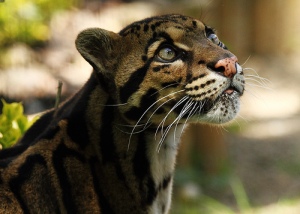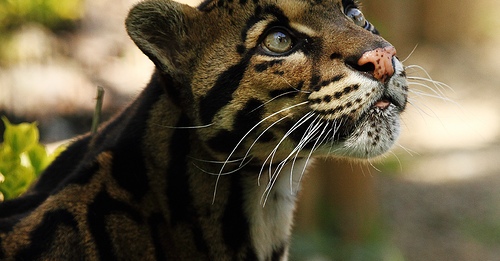Sunda Clouded Leopard
Neofelis diardi

The Sunda clouded leopard is a separate species from the Asian clouded leopard (Neofelis nebulosa) and the two species separated more than 1.4million years ago making them no more related than leopards and lions. The Sunda clouded leopard was categorised in 2006 into two separate subspecies based on genetic analysis, one species on the island of Borneo and the other on Sumatra (Buckley-Beason et al. 2006).
The Sunda leopard is a stocky medium sized felid which weighs around 12-25kg with a body length of 62-95cm. It differs from the Clouded leopard in both size, as the Sunda leopard is shorter and more heavily built and also in its dentition. The Sunda clouded leopard has the largest canine teeth in relation to size of any felid which may be an adaptation to holding prey in trees. Being strongly arboreal, the Sunda Leopard has a tail which can grow to the length of its body for balance.
Conservation Status: (From IUCN red list) Endangered
Subspecies:
N.d. ssp.diardi- Sumatran Sunda Clouded Leopard
N.d. ssp. borneensis- Bornean Sunda Clouded Leopard
Physical Description
Like all clouded leopards, the Sunda clouded leopard has irregular black ovals across their coats which have given rise to its common name. These dark markings contrast on a golden base to give camouflage in dense forest and jungle. The Sunda clouded leopard has more spotted ovals than the Asian clouded leopard.
Like nearly all cats, the Sunda clouded leopard has soft pads and retractable claws. These help in catching prey and climbing trees. They also have forward facing eyes and binocular vision typical of a predatory species and large rounded ears for hearing prey and potential threats in the dense jungle. The Sunda Clouded leopard has hind legs which are longer than its forelimbs. This helps with agility in the trees and for pouncing. They also have flexible ankle joints which allow them to climb down trees head first.

A young male Sunda Clouded leopard caught by camera trap in Borneo
Range and Distribution
There is no population estimate of Sunda leopards yet known. Camera trap sampling is being conducted to estimate the population as this is the most effective means of recording this elusive species. What is now known is that the Sumatran Sunda leopard is found in lower densities and higher altitudes than the Borneo subspecies, which can be found in lowland forests. This is probably because the Borneo Sunda clouded leopard is the largest felid carnivore on the island, whereas than in other areas tigers and cloud leopards are sympatric.

Estimated range of both the subspecies of the Sunda Clouded Leopard
Ecology
Very little in known about the Sunda clouded leopard. Like their Asian cousins they are very elusive and wary of people. It is assumed that their ecology differs little from clouded leopards however studies are currently underway.
Diet- Sunda cloud leopards will depredate a variety of prey including various ungulates such as Sambar deer, Muntjac deer and mouse deer as well as bearded pigs, civets, fish and monkeys (Rabinowitz et al. 1987).
Life history-As yet not fully documented, although likely to follow similar patterns to the clouded leopard.
Habitat- the Sunda Clouded leopard has been found in most forest habitat sufficiently dense enough for them to stalk their prey with sufficient camouflage. They are arboreal cats and will drag kills into trees. The Borneo Sunda leopard however, has been found to spend more time on the ground than its Sumatran subspecies which is probably due to the lack of other large felid competition for prey.
Threats
The Sunda leopard is dependent on the presence of forest and jungle as they are partially arboreal. Unfortunately, Borneo and Sumatra are undergoing the world’s highest deforestation rates (over 10% of lowland forest was lost in the past ten years) (Rautner et al. 2005). Logging and clearing for agriculture is pushing the Sunda leopard deeper into its range and fragmenting its habitat. Palm oil is also a massively expanding industry in Borneo which is negatively affecting leopard numbers by deforesting huge areas of land for plantations. Indonesia and Malaysia are now the biggest suppliers of palm oil in the world, and this industry is still growing (Koh & Wilcove, 2007).
Snare traps have also been a huge problem for the Sunda Leopard population. Snare traps are used indiscriminately for hunting other species but the leopards are caught by accident. Due to the high commercial value of their pelts and body parts they are then sold on (Holden, 2001).
Conservation
The subspecies of Sunda clouded leopard from Borneo is listed as endangered (CITES Appendix I as Neofelis nebulosa as yet it has not been reclassified in conservation initiatives) and is fully protected in Kalimantan (Indonesia), Sabah and Sarawak (Malaysia) and Brunei (IUCN Cats Red List workshop, 2007). However, in many parts of Borneo, the Sunda leopard has been caught by camera traps well outside of protected area.
As so little is known about the Borneo Sunda leopard as a distinct species, there are few conservation strategies in place. A camera trapping programme is currently underway to assess the distribution and population estimates of this elusive cat. This is being conducted by the Bornean clouded leopard programme which was created from collaboration between the Sabah Wildlife Department and the WildCRU.
Until more is known about the Bornean Clouded leopard subspecies, little can be put in to place to fully protect it. The main issue faced by the Sunda leopard is of habitat destruction which is a factor for all endangered cat species and can only be resolved by legislation to control deforestation in poor countries.
Conservation
The subspecies of Sunda clouded leopard from Borneo is listed as endangered (CITES Appendix I as Neofelis nebulosa as yet it has not been reclassified in conservation initiatives) and is fully protected in Kalimantan (Indonesia), Sabah and Sarawak (Malaysia) and Brunei (IUCN Cats Red List workshop, 2007). However, in many parts of Borneo, the Sunda leopard has been caught by camera traps well outside of protected area.
Emma Gardner, AWF Feline Researcher












